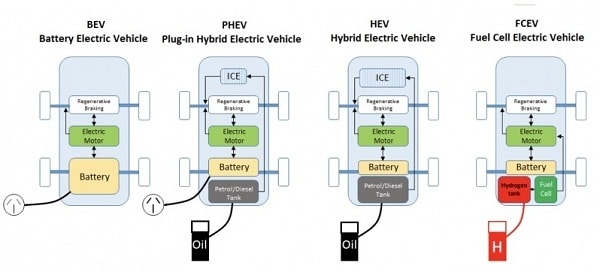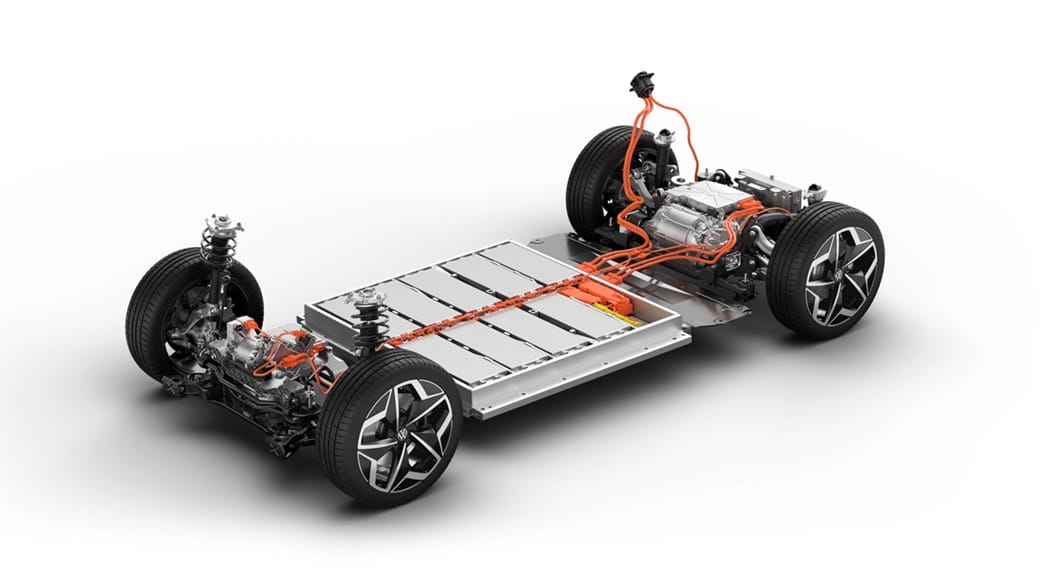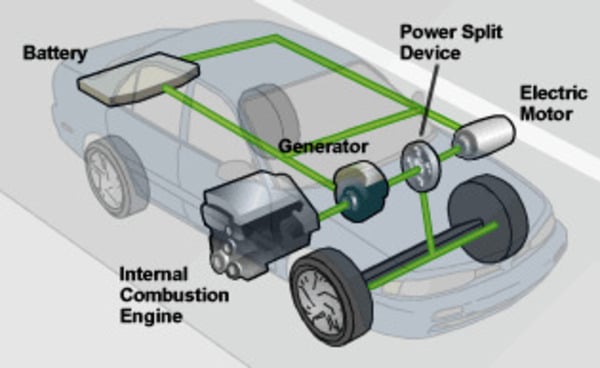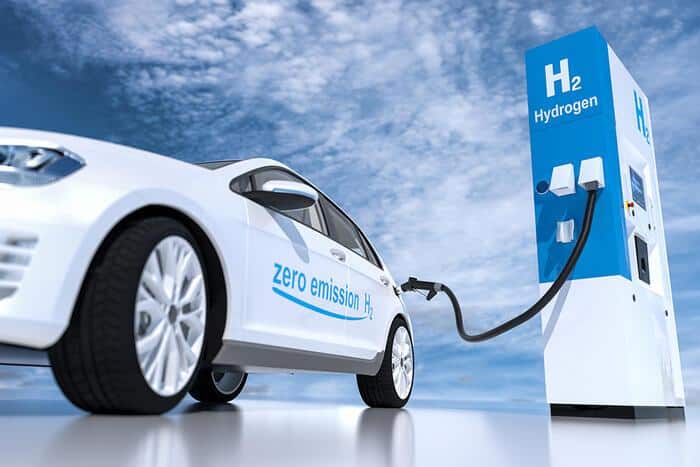Electric cars have a different way of working when compared to conventional engined vehicles. The propulsion system is simpler, and there are several types.
Over time the trend of electric cars is increasing. Many manufacturers are starting to release electrified products. Coupled with the support of the Indonesian government through infrastructure development and tax incentives for electric cars.
One of the attractions of electric cars is that they are more environmentally friendly than cars with internal combustion systems or internal combustion engines (ICE). Electric cars do not produce exhaust emissions, are quiet when driven, and their performance can compete with ICE cars.
Important Components of Electric Cars
The components contained in an electric car vary and have different functions. Broadly speaking, there are three main components embedded in an electric car.
Traction Battery Pack
Of course, every car needs a “container” to accommodate its resources. An electric car requires a traction battery/traction battery pack to accommodate electric power as the main energy source for driving the car. Usually, the electric power storage system is in the form of direct current (DC).
Over time, batteries for electric cars have developed so that there are many types. Now, the commonly used electric car battery is made of Lithium-ion Battery. This battery is a type of battery that is widely used in modern electric cars because it is considered to have high durability.
Keep in mind, the battery only functions as a power source for the propulsion system in electric cars. Meanwhile, electrical energy for electrical components such as lights and the like is still supported by the battery.
Power Inverters
Another important component in an electric car is the power inverter or power inverter. This component functions to convert direct current (DC) electricity into alternating current (AC). This AC current is used to drive the traction motor.
Plus, the power inverter also has the function of charging the car battery. When the car decelerates or slows down, the power inverter will convert the resulting AC current into DC current which is then accommodated back into the battery.
Traction Motor
The traction motor component is the final destination of the electric current from the battery. In an electric car usually has one or more traction motors to turn the car wheels.
If compared, this traction motor is the same as an electric dynamo on a toy car. Its function is to convert electrical power into kinetic power through the process of interaction between electromagnetic and permanent magnets in the motor.
Compared to conventional combustion engines, of course, traction motors are more efficient in terms of the energy they produce. This is because conventional combustion engines also produce heat energy, so the power from burning gasoline in the engine is not fully converted into kinetic energy.
Meanwhile, the traction motor converts electrical energy into kinetic energy more fully. In addition, the motor system is simpler without the need for a transmission or components that, for example, convert the vertical motion of a conventional engine piston into rotational movement of the wheels.
Electric Car Charger
This component is a support for electric cars. As the name implies, its function is to recharge the electric power in the electric car battery using an external power source such as the electricity network.
The way it works is simple, just like charging other electronic devices such as laptops or cellphones. The AC electric current of the network is converted into DC current which is then charged into the battery.
How Electric Cars Work in General
If translated, how the electric car works is actually simple. Electrical power in the battery is channeled to an electric motor to drive the car wheels.
Here’s an explanation of how it works step by step:
- When the acceleration pedal is pressed, the control module regulates the flow of electric power from the battery to the inverter
- The inverter changes the electric current from DC to AC, then is channeled to the traction motor according to the pressure on the accelerator pedal
- Traction motor converts electrical power into kinetic energy (rotation/rotation)
- Rotation of the rotor in the traction motor then drives the transmission to rotate the wheels, so that the car runs
Types of Electric Cars
There are four types of electric cars, namely Battery Electric Vehicle (BEV), Hybrid Electric Vehicle (HEV), Plug-in Hybrid Vehicle (PHEV), and Fuel Cell Electric Vehicle (FCEV).

Battery Electric Vehicles (BEVs)
This type of car operates entirely on electricity from the battery. There is no internal combustion engine. Electricity is stored in battery packs. Charging by connecting the battery to an external power source.

Electrical power is converted from DC to AC to run the motor. The accelerator pedal sends a signal to the control module to adjust the vehicle speed by changing the frequency of the AC power from the inverter to the traction motor.
When the brake pedal is pressed or the car slows down, the motor becomes a generator that generates electricity, which is stored back in the battery.
There are many electric cars of this type, namely the Volkswagen e-Golf, Tesla Model 3, BMW i3, Chevrolet Bolt, Nissan Leaf, Hyundai Ioniq 5, and others.
Hybrid Electric Vehicles (HEV)
The HEV type electric car has two propulsion systems, namely an internal combustion engine and a traction motor. The internal combustion engine is powered by gasoline, while the motor is powered by a battery. Both can rotate the wheel drive transmission at the same time.

The uniqueness of the HEV from other types of electric cars is that the battery is only charged due to engine rotation, wheel movement, or a combination thereof. When braking, the traction motor turns into a generator which charges electricity to the battery.
The HEV type electric car does not have a charging port so the battery cannot be recharged externally. Some examples of this type of electric car are the Honda Civic Hybrid, Toyota C-HR Hybrid, Toyota Camry Hybrid, and others.
Plug-in Hybrid Electric Vehicles (PHEV)
The PHEV car, similar to the HEV, has two propulsion systems, an internal combustion engine and a traction motor. However, PHEV cars have a charging port so that the battery can be recharged using an external power source.
Usually cars with PHEV technology can operate in two modes. The first is the electric mode where the propulsion of the car uses a fully electric motor. In both hybrid modes, the engine and motor work together.
In Indonesia there are several manufacturers that have marketed cars with PHEV technology, including the Toyota Prius PHEV and Mitsubishi Outlander PHEV.
Fuel Cell Electric Vehicle (FCEV)
FCEV uses hydrogen as an energy source to generate electricity from the fuel cell system. On the car there is a tank to hold hydrogen.

The way it works is almost similar to the HEV electric car, namely hydrogen is channeled into the Fuel Cell system, then the chemical energy is converted into electrical energy to power the electric motor and charge the battery.
As with other types of electric cars, when decelerating the motor will become a generator that produces electricity, then accommodated in the battery.
FCEV type electric cars are still rarely found in Indonesia. Examples of cars that use fuel cells are the Toyota Mirai, Hyundai Tuscon FCEV, Honda Clarity Fuel Cell, and Hyundai Nexo.
Advantages of Electric Cars
Now we know how electric cars work differently from conventional cars, because of this difference, electric cars have several advantages.
Environmentally friendly
There is no combustion in the engine to produce exhaust gas, electric cars are seen as environmentally friendly vehicles.
Not Noisy
The traction motor in an electric car does not produce the noise that is heard in a conventional car. The electric car cabin is quieter and the driving experience is more comfortable,
Save on Treatment Costs
The number of components in a pure electric car’s drive system is far less than that of a conventional car. No more using engine oil, changing spark plugs, radiator water and other components. So, maintenance of electric cars becomes cheaper and more efficient.
Lack of Electric Cars
Electric cars still have drawbacks that make people think twice about buying them.
Expensive price
The main thing that is considered by potential electric car buyers is the price.
Not Enough Infrastructure Support
In Indonesia, currently there are not many public electric vehicle charging stations (SPKLU). SPKLU are mostly found in several malls, dealers, and toll road rest areas.
Of course, this will worry people who want to use electric cars for long trips.
Old Battery Recharge
Recharging electric car batteries is considered long. To fully charge it can take hours. This is very different from conventional gasoline cars, which only take a few minutes to fill.
